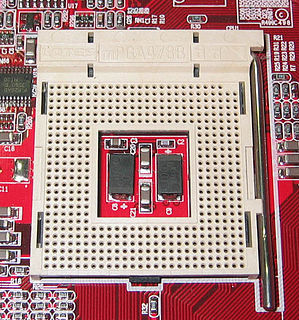Celeron is a brand name given by Intel to a number of different low-end IA-32 and x86-64 computer microprocessor models targeted at low-cost personal computers.
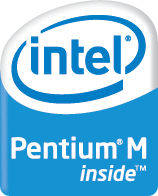
The Pentium M is a family of mobile 32-bit single-core x86 microprocessors introduced in March 2003 and forming a part of the Intel Carmel notebook platform under the then new Centrino brand. The Pentium M processors had a maximum thermal design power (TDP) of 5–27 W depending on the model, and were intended for use in laptops. They evolved from the core of the last Pentium III–branded CPU by adding the front-side bus (FSB) interface of Pentium 4, an improved instruction decoding and issuing front end, improved branch prediction, SSE2 support, and a much larger cache. The first Pentium M–branded CPU, code-named Banias, was followed by Dothan. The Pentium M-branded processors were succeeded by the Core-branded dual-core mobile Yonah CPU with a modified microarchitecture.

A pin grid array, often abbreviated PGA, is a type of integrated circuit packaging. In a PGA, the package is square or rectangular, and the pins are arranged in a regular array on the underside of the package. The pins are commonly spaced 2.54 mm (0.1") apart, and may or may not cover the entire underside of the package.
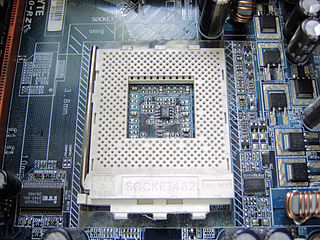
In computer hardware, a CPU socket or CPU slot comprises one or more mechanical components providing mechanical and electrical connections between a microprocessor and a printed circuit board (PCB). This allows for placing and replacing the central processing unit (CPU) without soldering.

The land grid array (LGA) is a type of surface-mount packaging for integrated circuits (ICs) that is notable for having the pins on the socket rather than the integrated circuit. An LGA can be electrically connected to a printed circuit board (PCB) either by the use of a socket or by soldering directly to the board.

LGA 775, also known as Socket T, is an Intel desktop CPU socket. LGA stands for land grid array. Unlike earlier common CPU sockets, such as its predecessor Socket 478, the LGA 775 has no socket holes; instead, it has 775 protruding pins which touch contact points on the underside of the processor (CPU).
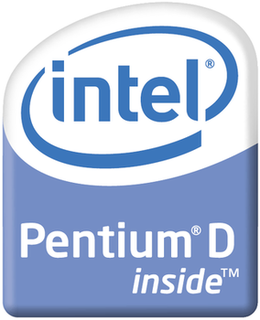
The Pentium D brand refers to two series of desktop dual-core 64-bit x86-64 microprocessors with the NetBurst microarchitecture, which is the dual-core variant of Pentium 4 "Prescott" manufactured by Intel. Each CPU comprised two dies, each containing a single core, residing next to each other on a multi-chip module package. The brand's first processor, codenamed Smithfield, was released by Intel on May 25, 2005. Nine months later, Intel introduced its successor, codenamed Presler, but without offering significant upgrades in design, still resulting in relatively high power consumption. By 2004, the NetBurst processors reached a clock speed barrier at 3.8 GHz due to a thermal limit exemplified by the Presler's 130 watt thermal design power. The future belonged to more energy efficient and slower clocked dual-core CPUs on a single die instead of two. The final shipment date of the dual die Presler chips was August 8, 2008, which marked the end of the Pentium D brand and also the NetBurst microarchitecture.
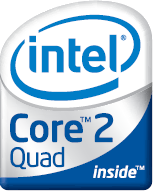
The Intel Core microarchitecture is a multi-core processor microarchitecture unveiled by Intel in Q1 2006. It is based on the Yonah processor design and can be considered an iteration of the P6 microarchitecture, introduced in 1995 with Pentium Pro. The high power consumption and heat intensity, the resulting inability to effectively increase clock speed, and other shortcomings such as the inefficient pipeline were the primary reasons for which Intel abandoned the NetBurst microarchitecture and switched to completely different architectural design, delivering high efficiency through a small pipeline rather than high clock speeds. The Core microarchitecture never reached the clock speeds of the Netburst microarchitecture, even after moving to 45 nm lithography; however, after many generations of successor microarchitectures which are developed with the Core as the basis Intel managed to surpass the clock speeds of Netburst using the Devil's Canyon microarchitecture which reached a base frequency of 4 GHz and a maximum tested frequency of 4.4 GHz using 22 nm lithography and ultimately derives from the P6 microarchitecture through the Core microarchitecture and many other succeeding improvements.
Yonah was the code name for Intel's first generation of 65 nm process mobile microprocessors, based on the Banias/Dothan-core Pentium M microarchitecture. SIMD performance has been improved through the addition of SSE3 instructions and improvements to SSE and SSE2 implementations, while integer performance decreased slightly due to higher latency cache. Additionally, Yonah includes support for the NX bit.

LGA 771, also known as Socket J, is a CPU interface introduced by Intel in 2006. It is used in Intel Core microarchitecture based DP-capable server processors, the Dual-Core Xeon is codenamed Dempsey, Woodcrest, and Wolfdale and the Quad-Core processors Clovertown, Harpertown, and Yorkfield-CL. It is also used for the Core 2 Extreme QX9775.

LGA 2011, also called Socket R, is a CPU socket by Intel. Released on November 14, 2011, it replaces Intel's LGA 1366 and LGA 1567 in the performance and high-end desktop and server platforms. The socket has 2011 protruding pins that touch contact points on the underside of the processor.
In Intel's Tick-Tock cycle, the 2007/2008 "Tick" was the shrink of the Core microarchitecture to 45 nanometers as CPUID model 23. In Core 2 processors, it is used with the code names Penryn, Wolfdale and Yorkfield, some of which are also sold as Celeron, Pentium and Xeon processors. In the Xeon brand, the Wolfdale-DP and Harpertown code names are used for LGA 771 based MCMs with two or four active Wolfdale cores.

Socket G2, also known as rPGA 988B is Intel's CPU socket used with their line of mobile Core i7, the successor to the Core 2 line, and also with several mobile Core i5 and Core i3 processors. It is based on Intel's Sandy Bridge architecture. Like its predecessor, socket G1 systems, it can only run in dual-channel memory mode, but with data rates up to 1600 MHz. They are also known as FCPGA988 socket processors. Which should be pin compatible with PPGA988.






